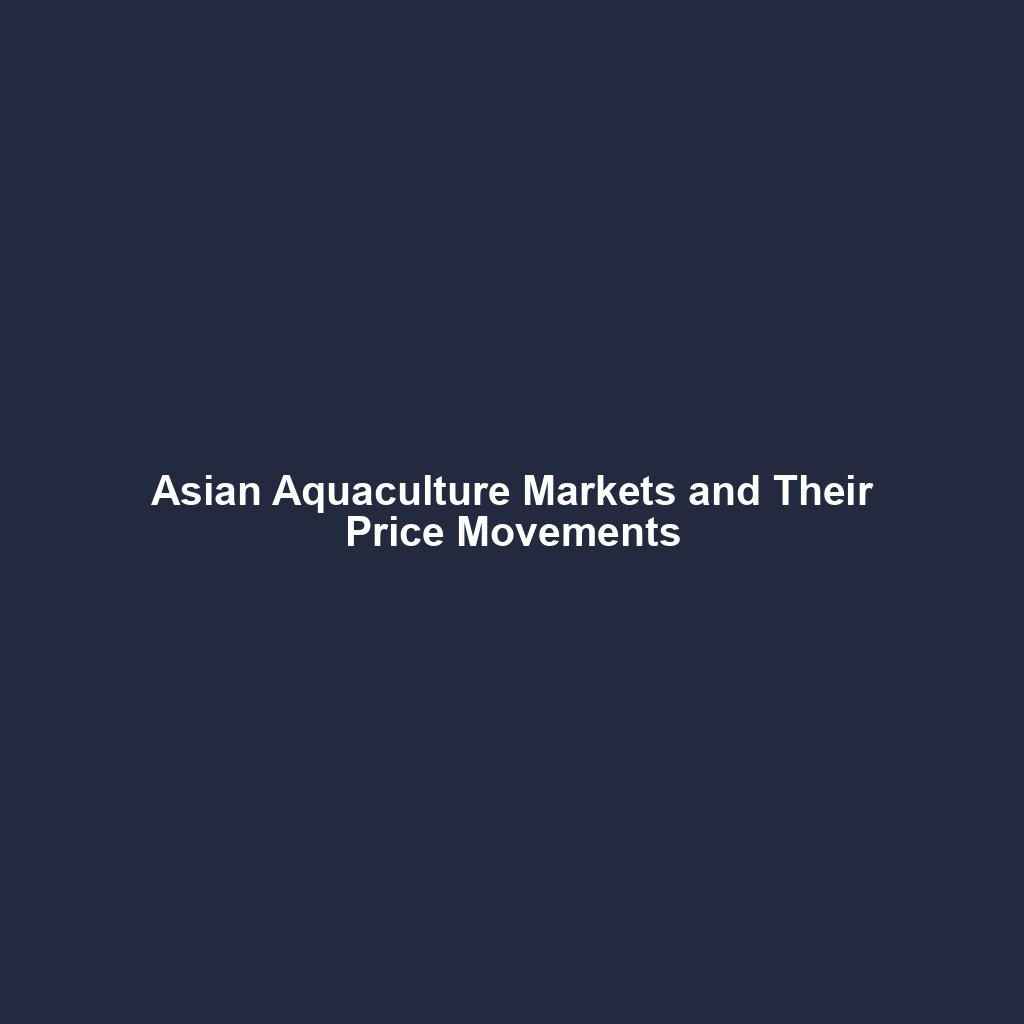
Introduction to Asian Aquaculture Markets
Aquaculture, the farming of aquatic organisms such as fish, crustaceans, mollusks, and aquatic plants, has become a significant sector in Asia. The region’s favorable climatic conditions, extensive coastline, and rich biodiversity make it an ideal location for aquaculture activities. Countries like China, India, Vietnam, and Thailand are leading players in the global aquaculture market, contributing significantly to the world’s seafood supply. This article delves into the dynamics of Asian aquaculture markets and examines the factors influencing price movements within this sector.
Chapter 1: Overview of Asian Aquaculture Markets
1.1 Historical Context and Growth
The history of aquaculture in Asia dates back thousands of years, with early practices documented in ancient China. Over the centuries, traditional methods have evolved into sophisticated, technology-driven operations. The rapid growth of the aquaculture industry in recent decades can be attributed to increasing demand for seafood, advancements in farming techniques, and supportive government policies.
China, the world’s largest producer of aquaculture products, accounts for more than 60% of global production. Other significant contributors include India, Indonesia, Vietnam, and Bangladesh. These countries have invested heavily in infrastructure, research, and development to enhance productivity and sustainability in aquaculture.
1.2 Key Species and Production Systems
Asian aquaculture is characterized by a diverse range of species and production systems. Key species include finfish (such as carp, tilapia, and catfish), crustaceans (such as shrimp and crabs), and mollusks (such as oysters and mussels). Each species requires specific farming conditions, feeding practices, and management techniques.
Production systems in Asia vary from extensive, low-input methods to intensive, high-input systems. Extensive systems rely on natural food sources and minimal human intervention, while intensive systems involve controlled environments, artificial feeding, and advanced technology. Semi-intensive systems, which combine elements of both, are also common.
1.3 Economic and Social Impact
The aquaculture industry plays a crucial role in the economies of many Asian countries. It provides employment opportunities, supports rural livelihoods, and contributes to food security. In addition to direct employment in farming activities, the industry generates jobs in related sectors such as feed production, processing, and distribution.
Moreover, aquaculture has significant social implications. It helps alleviate poverty in rural areas, promotes gender equality by providing opportunities for women, and supports community development. However, the industry also faces challenges such as environmental degradation, disease outbreaks, and market volatility.
Chapter 2: Price Movements in Asian Aquaculture Markets
2.1 Factors Influencing Price Movements
Several factors influence price movements in Asian aquaculture markets. Understanding these factors is essential for stakeholders to make informed decisions and manage risks effectively. Key factors include:
- Supply and Demand: The balance between supply and demand is a primary determinant of prices. Factors such as production levels, seasonal variations, and consumer preferences impact supply and demand dynamics.
- Input Costs: The cost of inputs such as feed, seed, labor, and energy affects production costs and, consequently, prices. Fluctuations in input costs can lead to price volatility.
- Environmental Conditions: Weather patterns, water quality, and disease outbreaks can impact production and supply, leading to price fluctuations. For example, adverse weather conditions can reduce yields, causing prices to rise.
- Government Policies: Policies related to trade, subsidies, and regulations can influence prices. For instance, export restrictions or import tariffs can affect market dynamics and price levels.
- Global Market Trends: International market trends, including changes in global demand, exchange rates, and competition from other producing countries, can impact prices in Asian aquaculture markets.
2.2 Price Analysis Techniques
Analyzing price movements in aquaculture markets involves various techniques and tools. These methods help stakeholders understand market trends, forecast future prices, and make strategic decisions. Common price analysis techniques include:
- Time Series Analysis: This technique involves analyzing historical price data to identify patterns, trends, and seasonal variations. Time series analysis can help forecast future prices based on past behavior.
- Supply and Demand Models: These models analyze the relationship between supply, demand, and prices. They consider factors such as production levels, consumption patterns, and market equilibrium to predict price movements.
- Econometric Models: Econometric models use statistical methods to analyze the impact of various factors on prices. These models can incorporate multiple variables, such as input costs, environmental conditions, and policy changes, to provide a comprehensive analysis.
- Market Surveys and Expert Opinions: Surveys and expert opinions provide qualitative insights into market conditions and price expectations. These methods complement quantitative analysis and offer a broader perspective on market dynamics.
2.3 Case Studies of Price Movements
Examining specific case studies can provide valuable insights into the factors driving price movements in Asian aquaculture markets. Here are a few examples:
- Shrimp Prices in India: India is a major producer of farmed shrimp, with significant exports to global markets. In recent years, shrimp prices have experienced volatility due to factors such as disease outbreaks, changes in international demand, and fluctuations in input costs. For instance, the outbreak of the Early Mortality Syndrome (EMS) in shrimp farms led to a sharp decline in production and a subsequent increase in prices.
- Tilapia Prices in China: China is the world’s largest producer of tilapia, a popular aquaculture species. Tilapia prices in China have been influenced by factors such as feed costs, environmental regulations, and competition from other producing countries. For example, stricter environmental regulations aimed at reducing pollution have led to increased production costs and higher prices.
- Catfish Prices in Vietnam: Vietnam is a leading producer of catfish, particularly the Pangasius species. Catfish prices in Vietnam have been affected by factors such as export demand, input costs, and trade policies. For instance, changes in trade policies by importing countries, such as the imposition of anti-dumping duties, have impacted catfish prices.
2.4 Strategies for Managing Price Risks
Price volatility poses significant risks for stakeholders in the aquaculture industry. Effective risk management strategies can help mitigate these risks and ensure business sustainability. Some common strategies include:
- Hedging: Hedging involves using financial instruments, such as futures contracts and options, to protect against adverse price movements. By locking in prices in advance, producers and traders can reduce their exposure to price volatility.
- Diversification: Diversifying production and markets can help spread risks. For example, farmers can cultivate multiple species or target different markets to reduce dependence on a single product or market.
- Contract Farming: Contract farming arrangements with buyers can provide price stability and reduce market risks. Under such agreements, farmers agree to supply a specified quantity of produce at predetermined prices.
- Insurance: Insurance products, such as crop insurance and aquaculture insurance, can provide financial protection against risks such as disease outbreaks, natural disasters, and market fluctuations.
- Market Intelligence: Access to timely and accurate market information is crucial for making informed decisions. Market intelligence tools, such as price monitoring systems and market reports, can help stakeholders stay updated on market trends and price movements.
Conclusion
The Asian aquaculture markets are dynamic and complex, influenced by a multitude of factors ranging from environmental conditions to global market trends. Understanding the intricacies of these markets and the factors driving price movements is essential for stakeholders to navigate the challenges and seize opportunities. By employing effective price analysis techniques and risk management strategies, stakeholders can enhance their decision-making processes and contribute to the sustainable growth of the aquaculture industry in Asia.



